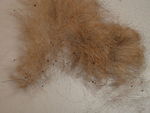Difference between revisions of "Flea Habitat and Control"
Jump to navigation
Jump to search
| Line 2: | Line 2: | ||
==Habitats== | ==Habitats== | ||
| − | Although adult fleas are obligate blood feeders only 5% of the flea population will be on an animal at any one time. | + | Although adult fleas are obligate blood feeders only 5% of the flea population will be on an animal at any one time. The remaining population inhabits the surrounding environment, though they are never far from a potential host species. The population that is not on the host consists of eggs, larvae, pupae and unfed adults. In the environment the adult fleas as well as the other stages are found in 'hot spots' where a potential host animal spends most of its time. These areas are usually warm, shady and humid and therefore usually indoors in regions with a cooler climate. |
| − | |||
| − | |||
| − | |||
| − | |||
*Fleas accumulate in certain '''hot spots''' where the animal spends the majority of its time | *Fleas accumulate in certain '''hot spots''' where the animal spends the majority of its time | ||
Revision as of 17:04, 25 July 2010
| This article is still under construction. |
Habitats
Although adult fleas are obligate blood feeders only 5% of the flea population will be on an animal at any one time. The remaining population inhabits the surrounding environment, though they are never far from a potential host species. The population that is not on the host consists of eggs, larvae, pupae and unfed adults. In the environment the adult fleas as well as the other stages are found in 'hot spots' where a potential host animal spends most of its time. These areas are usually warm, shady and humid and therefore usually indoors in regions with a cooler climate.
- Fleas accumulate in certain hot spots where the animal spends the majority of its time
- E.g. Warm, shady, humid ares
- E.g. Outdoors in warmer climates or inside in temperate climates
- Very large numbers of eggs are found in areas where cats land after jumping as they have been dislodged
- E.g. Beside sofas
Control
- Single or occasional treatments will only give temporary relief from fleas as the majority of the population is in the environment
- Appropriate action must be taken to stop re-infestation
- The animal must be rid of its resident flea population
- The animal should be protected against subsequent re-infestation
- From within the home
- From outside the home
- The environmental reservoir population should be eliminated
- Animal treatment to deplete reservoir
- Adulticides
- Adulticides with larvicidal effects
- Insect growth regulators (IGR's)
- Direct chemical treatment of domestic environment
- Insecticides
- Insect growth regulators
- Inorganic chemicals
- Entomophagous nematodes (These are parasitic nematodes which predate other parasite eggs)
- Animal treatment to deplete reservoir
- To prevent resistance occurring, control methods should not rely solely on chemical methods
- Hygiene such as regular vacuuming and washing of the animal's bedding should also occur for the most effective treatment
- For more information on the chemicals used for flea treatment click

